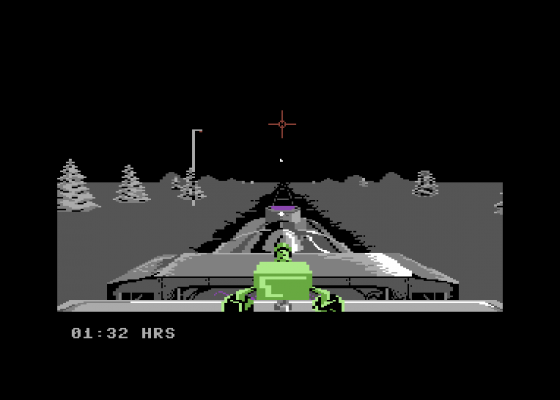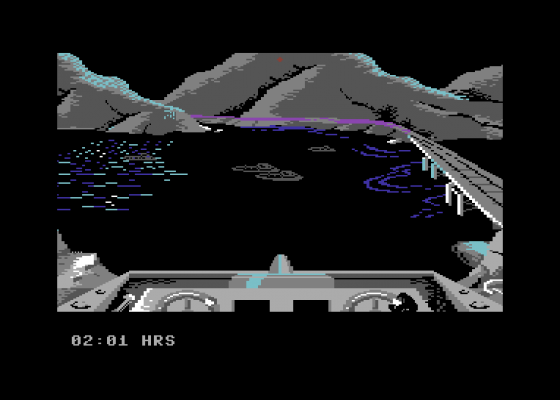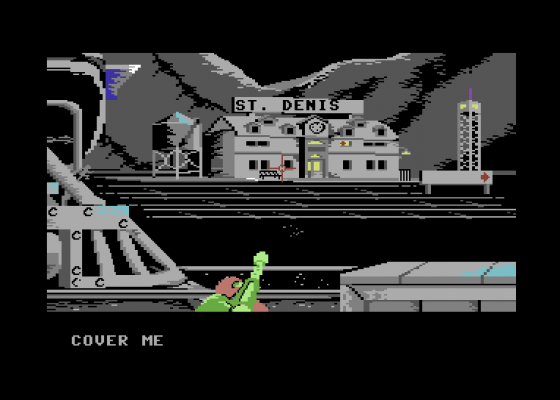The Train
It's August, 1944. The Nazis' stranglehold on Europe has begun to loosen, and the Germans are evacuating with their spoils in tow. A secret train stands on the outskirts of Metz in France, holding a cargo of valuable art treasures which are destined for Berlin and Hitler's own private collection.
However, a plan is afoot to foil the Fuhrer The player takes the role of Pierre LeFeu, a French Resistance leader whose mission is to capture the train and take the stolen art treasures back through enemy lines to rendezvous with the Allies at Riviere in Normandy.
The first action screen is set in the Metz railway yard where the train is waiting to leave for Germany. LeFeu gives covering fire while his injured comrade, Le Duc, runs across the tracks to collect the points switch - switching tracks effectively enables the player to select the length and difficulty of the train's route to Riviere.

Enemy troops occupy the station and their silhouettes are seen in the windows as they attempt to get a shot at LeFeu. A spray of automatic gunfire tracks along the ground toward LeFeu, who is forced to duck before being hit. LeFeu's shots are directed by a floating cursor, and he keeps the enemy occupied long enough for Le Duc to get back to the train.
Once the points are switched, LeFeu takes control of the engine, with three control screens at the player's disposal: two perspective views are given to front and rear of the train, allowing targetting of the machine guns in case of air attack, and the third view is that from the footplate showing the train's controls. All the engine's vital aspects are mantained from here, including stoking the boiler, throttle and brake controls and checking the necessary gauges.
Le Duc constantly proffers advice during the trip, and gives warnings should certain gauges begin to run too high or too low. He also warns of imminent arrivals at stations, bridges or points switches, allowing the player time to slow the train to a stop or signal his intended route via the whistle. A map screen showing the train's position is also available during the journey to give information on what is coming next along the line.

Stations are captured en route by machine-gunning all the occupying troops. This allows LeFeu to read German intelligence messages pertaining to the state of certain sections of the track. The station's telegraph can also be used to send messages to the Resistance, calling for repairs or for their help in securing an occupied bridge or station.
On reaching a bridge, a view of the river appears with patrolling enemy gunboats. The boats waste no time in firing on the engine, but are destroyed with the 155mm cannon mounted on a flat-car at the centre of the train, by adjusting the cannon elevation to obtain the correct range. Failing to destroy the boats in time sees the engine put out of action by a hail of enemy fire.
The engine is also under constant threat of bombing by enemy aircraft which frequently buzz the train. Fast and accurate aiming of the machine guns at the front and rear of the train are required to fend off these attacks.

Journey's end arrives when either the mission is complete or cannot be continued because of damage to the engine or artworks, or death of the crew. The player's score is then rated on the basis of aircraft, soldiers and boats destroyed, and is given status percentages on damage to the boiler, brakes and the artworks, as well as coal left in the hopper and number of requests made of the Resistance.
GH
From the same mould as Ace Of Aces comes another superb arcade-style simulation. The complete package is brilliantly put together to produce an action-packed, beautifully evocative and compulsive game. The neatly drawn graphics are more than merely functional and really create an appropriately sombre and austere wartime atmosphere.
The train interior contains some particularly striking effects: the warm furnace glow, accompanied by a low, fiery rumbling, the variable rhythms of the engine, the whistle: all sights and sounds are spot-on. It really appeals to a combination of the urge to be an engine driver and the desire to outwit or destroy an enemy; there's a constant need to keep an eye on the gauges or watch the skies for fighters.

It's a very easy game to get into, and even if you complete the mission, there's always the desire to do it again with less damage or at a more difficult level.
What I particularly like is the total freedom of movement: you can switch points, re-visit stations, reverse, change lines, anything! However, this leads to my only reservation: the cassette version may not be so fluid. Otherwise, it's excellent: good instructions, quick multi-load, useful status screens and good occasional effects. I've no hesitation in recommending it.
JR
Based on the superb 1966 Burt Lancaster film of the same name, The Train is packed with atmosphere and playability. The action is very much in the Dambusters and Ace Of Aces mould, but this time the player drives a train across wartime France.

Each of the scenes is well thought out, and all contribute to the incredible feeling of involvement - you can do just about anything you like within the game's environment. The shooting sections are really tense as you try and out-gun the German guards and entering stations to relay messages to the Resistance and read up German intelligence is great, especially when you're trying to plan a route.
My favourite part, though, is actually driving the train itself. The driver's cab screen is extremely well drawn - there are plenty of levers to pull and wheels to twist, and you've also got to keep an eye on the fuel and pressure gauges, just in case more coal has to be shovelled into the furnace. Being able to pull the whistle is the icing on the cake!
As well as driving the train, you've also got to keep an eye on the map, and watch out for enemy attack - the action certainly keeps you busy! The Train is a very absorbing and entertaining action game. Catch it!
PG

You might think The Train would appeal solely to loco buffs, but this really isn't the case. I'd put this game more in the class of an interactive war movie, because the scenic graphics and realistic sound effects bestow it wth a definite film-style atmosphere.
All of the little shooting sub-games are most enjoyable, and the simulated engine-driving is particularly well implemented, with the control method and the advice from Le Duc cutting out any of the confusion which can mar a simulation.
What adds to this game no end are the numerous impressive little touches. Notable examples are the roaring sound and the flickering highlights which appear on the control surfaces as the firebox door is opened, and then there are the remarkable steam whistle and aero-engine effects.

The Train is one game I would recommend to anyone. Let's just hope the multi-load cassette version isn't too tedious...
Verdict
Presentation 95%
In-game difficulty selection and an abundance of other neat touches. Frequent, but rapid disk access.
Graphics 83%
Detailed and superbly atmospheric.

Sound 78%
Realistic effects make up for an imaginative but raucous version of 'La Marseillaise'.
Hookability 82%
Once the opening sequence is mastered, the game opens up and becomes increasingly addictive.
Lastability 83%
Several increasingly difficult routes to completion, but some sections may eventually become repetitive.
Overall 87%
Another excellent Accolade 'simulation', which should have a very wide appeal.
Other Reviews Of The Train: Escape To Normandy For The Commodore 64/128
The Train (Accolade)
A review
The Train (Accolade)
A review by Ken McMahon (Commodore User)


 1st April 1988
1st April 1988


